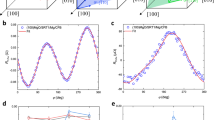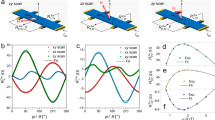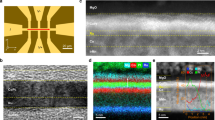Abstract
Electric-field manipulation of magnetic order has proved of both fundamental and technological importance in spintronic devices. So far, electric-field control of ferromagnetism, magnetization and magnetic anisotropy has been explored in various magnetic materials, but the efficient electric-field control of spin–orbit torque (SOT) still remains elusive. Here, we report the effective electric-field control of a giant SOT in a Cr-doped topological insulator (TI) thin film using a top-gate field-effect transistor structure. The SOT strength can be modulated by a factor of four within the accessible gate voltage range, and it shows strong correlation with the spin-polarized surface current in the film. Furthermore, we demonstrate the magnetization switching by scanning gate voltage with constant current and in-plane magnetic field applied in the film. The effective electric-field control of SOT and the giant spin-torque efficiency in Cr-doped TI may lead to the development of energy-efficient gate-controlled spin-torque devices compatible with modern field-effect semiconductor technologies.
This is a preview of subscription content, access via your institution
Access options
Subscribe to this journal
Receive 12 print issues and online access
$259.00 per year
only $21.58 per issue
Buy this article
- Purchase on Springer Link
- Instant access to full article PDF
Prices may be subject to local taxes which are calculated during checkout




Similar content being viewed by others
References
Ohno, H. et al. Electric-field control of ferromagnetism. Nature 408, 944–946 (2000).
Chiba, D., Yamanouchi, M., Matsukura, F. & Ohno, H. Electrical manipulation of magnetization reversal in a ferromagnetic semiconductor. Science 301, 943–945 (2003).
Tokura, Y. Multiferroics as quantum electromagnets. Science 312, 1481–1482 (2006).
Eerenstein, W., Mathur, N. D. & Scott, J. F. Multiferroic and magnetoelectric materials. Nature 442, 759–765 (2006).
Heron, J. T. et al. Deterministic switching of ferromagnetism at room temperature using an electric field. Nature 516, 370–373 (2014).
Maruyama, T. et al. Large voltage-induced magnetic anisotropy change in a few atomic layers of iron. Nature Nanotech. 4, 158–161 (2009).
Amiri, P. K. & Wang, K. L. Voltage-controlled magnetic anisotropy in spintronic devices. Spin 2, 1240002 (2012).
Ralph, D. C. & Stiles, M. D. Spin transfer torques. J. Magn. Magn. Mater. 320, 1190–1216 (2008).
Garello, K. et al. Symmetry and magnitude of spin-orbit torques in ferromagnetic heterostructures. Nature Nanotech. 8, 587–593 (2013).
Liu, R. H., Lim, W. L. & Urazhdin, S. Control of current-induced spin-orbit effects in a ferromagnetic heterostructure by electric field. Phys. Rev. B 89, 220409 (2014).
Bauer, U. et al. Magneto-ionic control of interfacial magnetism. Nature Mater. 14, 174–181 (2015).
Qi, X.-L. & Zhang, S.-C. Topological insulators and superconductors. Rev. Mod. Phys. 83, 1057–1110 (2011).
Hasan, M. Z. & Kane, C. L. Colloquium: topological insulators. Rev. Mod. Phys. 82, 3045–3067 (2010).
Moore, J. E. The birth of topological insulators. Nature 464, 194–198 (2010).
Fan, Y. et al. Magnetization switching through giant spin-orbit torque in a magnetically doped topological insulator heterostructure. Nature Mater. 13, 699–704 (2014).
Mellnik, A. R. et al. Spin-transfer torque generated by a topological insulator. Nature 511, 449–451 (2014).
Wang, Y. et al. Topological surface states originated spin-orbit torques in Bi2Se3 . Phys. Rev. Lett. 114, 257202 (2015).
Liu, L. et al. Spin-torque switching with the giant spin Hall effect of tantalum. Science 336, 555–558 (2012).
Liu, L., Lee, O. J., Gudmundsen, T. J., Ralph, D. C. & Buhrman, R. A. Current-induced switching of perpendicularly magnetized magnetic layers using spin torque from the spin Hall effect. Phys. Rev. Lett. 109, 096602 (2012).
Miron, I. M. et al. Perpendicular switching of a single ferromagnetic layer induced by in-plane current injection. Nature 476, 189–193 (2011).
Miron, I. M. et al. Current-driven spin torque induced by the Rashba effect in a ferromagnetic metal layer. Nature Mater. 9, 230–234 (2010).
Liu, L., Moriyama, T., Ralph, D. C. & Buhrman, R. A. Spin-torque ferromagnetic resonance induced by the spin Hall effect. Phys. Rev. Lett. 106, 036601 (2011).
Zhang, H. et al. Topological insulators in Bi2Se3, Bi2Te3 and Sb2Te3 with a single Dirac cone on the surface. Nature Phys. 5, 438–442 (2009).
Yazyev, O. V., Moore, J. E. & Louie, S. G. Spin polarization and transport of surface states in the topological insulators Bi2Se3 and Bi2Te3 from first principles. Phys. Rev. Lett. 105, 266806 (2010).
Hsieh, D. et al. A tunable topological insulator in the spin helical Dirac transport regime. Nature 460, 1101–1105 (2009).
Li, C. H. et al. Electrical detection of charge-current-induced spin polarization due to spin-momentum locking in Bi2Se3 . Nature Nanotech. 9, 218–224 (2014).
Tang, J. et al. Electrical detection of spin-polarized surface states conduction in (Bi0.53Sb0.47)2Te3 topological insulator. Nano Lett. 14, 5423–5429 (2014).
Ando, Y. et al. Electrical detection of the spin polarization due to charge flow in the surface state of the topological insulator Bi1.5Sb0.5Te1.7Se1.3 . Nano Lett. 14, 6226–6230 (2014).
Liu, L. et al. Spin-polarized tunneling study of spin-momentum locking in topological insulators. Phys. Rev. B 91, 235437 (2015).
Tian, J. et al. Topological insulator based spin valve devices: evidence for spin polarized transport of spin-momentum-locked topological surface states. Solid State Commun. 191, 1–5 (2014).
Fischer, M. H., Vaezi, A., Manchon, A. & Kim, E.-A. Large spin torque in topological insulator/ferromagnetic metal bilayers. Preprint at http://arxiv.org/abs/1305.1328 (2013).
Tserkovnyak, Y. & Bender, S. A. Spin Hall phenomenology of magnetic dynamics. Phys. Rev. B 90, 014428 (2014).
Shiomi, Y. et al. Spin-electricity conversion induced by spin injection into topological insulators. Phys. Rev. Lett. 113, 196601 (2014).
Deorani, P. et al. Observation of inverse spin Hall effect in bismuth selenide. Phys. Rev. B 90, 094403 (2014).
Jamali, M. et al. Giant spin pumping and inverse spin Hall effect in the presence of surface and bulk spin-orbit coupling of topological insulator Bi2Se3 . Nano Lett. 15, 7126–7132 (2015).
Baker, A. A., Figueroa, A. I., Collins-McIntyre, L. J., van der Laan, G. & Hesjedal, T. Spin pumping in ferromagnet-topological insulator-ferromagnet heterostructures. Sci. Rep. 5, 7907 (2015).
Kou, X. et al. Manipulating surface-related ferromagnetism in modulation-doped topological insulators. Nano Lett. 13, 4587–4593 (2013).
Kou, X. et al. Interplay between different magnetisms in Cr-doped topological insulators. ACS Nano 7, 9205–9212 (2013).
Lang, M. et al. Competing weak localization and weak antilocalization in ultrathin topological insulators. Nano Lett. 13, 48–53 (2013).
Kim, J. et al. Layer thickness dependence of the current-induced effective field vector in Ta|CoFeB|MgO. Nature Mater. 12, 240–245 (2013).
Lang, M. et al. Revelation of topological surface states in Bi2Se3 thin films by in situ al passivation. ACS Nano 6, 295–302 (2012).
Checkelsky, J. G., Ye, J., Onose, Y., Iwasa, Y. & Tokura, Y. Dirac-fermion-mediated ferromagnetism in a topological insulator. Nature Phys. 8, 729–733 (2012).
Skinner, B., Chen, T. & Shklovskii, B. I. Why is the bulk resistivity of topological insulators so small? Phys. Rev. Lett. 109, 176801 (2012).
He, L. et al. Evidence of the two surface states of (Bi0.53Sb0.47)2Te3 films grown by van der Waals epitaxy. Sci. Rep. 3, 3406 (2013).
Kong, D. et al. Ambipolar field effect in the ternary topological insulator (BixSb1-x)2Te3 by composition tuning. Nature Nanotech. 6, 705–709 (2011).
Zhang, J. et al. Band structure engineering in (Bi1-xSbx)2Te3 ternary topological insulators. Nature Commun. 2, 574 (2011).
Nagaosa, N., Sinova, J., Onoda, S., MacDonald, A. H. & Ong, N. P. Anomalous Hall effect. Rev. Mod. Phys. 82, 1539–1592 (2010).
Wang, J., Lian, B. & Zhang, S.-C. Electrically tunable magnetism in magnetic topological insulators. Phys. Rev. Lett. 115, 036805 (2015).
Zhang, W., Yu, R., Zhang, H.-J., Dai, X. & Fang, Z. First-principles studies of the three-dimensional strong topological insulators Bi2Te3, Bi2Se3 and Sb2Te3 . New J. Phys. 12, 065013 (2010).
Lang, M. et al. Proximity induced high-temperature magnetic order in topological insulator - ferrimagnetic insulator heterostructure. Nano Lett. 14, 3459–3465 (2014).
Acknowledgements
The material growth and characterizations were supported by the DARPA Meso program under contract No.N66001-12-1-4034 and N66001-11-1-4105. The device fabrication and low temperature measurements were supported as part of the Spins and Heat in Nanoscale Electronic Systems (SHINES), an Energy Frontier Research Center funded by the US Department of Energy (DOE), Office of Science, Basic Energy Sciences (BES), under Award # DE-SC0012670. The analysis and theoretical modelling were supported by the US Army Research Office under grants W911NF-14-1-0607 and W911NF-15-1-0561. We are also very grateful to the support from the FAME Center, one of six centers of STARnet, a Semiconductor Research Corporation program sponsored by MARCO and DARPA. Y.W. thanks the support of the National 973 Program of China (2013CB934600), National Science Foundation of China (11174244, 51390474) and Zhejiang Provincial Natural Science Foundation of China (LR12A04002).
Author information
Authors and Affiliations
Contributions
Y.F., X.K., P.U. and K.L.W. conceived and designed the research. X.K. and L.P. grew the material. M.L. and X.C. fabricated the Hall bar devices. Y.F. and Q.S. performed the measurements. X.K., P.U., L.P., M.L., X.C., J.T., M.M., K.M., L-T.C., M.A., G.Y., T.N. and K.W. contributed to the measurements and analysis. J.L. and Y.W. performed structural analysis. Y.F., P.U. and Y.T. designed the theoretical model. Y.F., X.K., P.U. and K.L.W. wrote the paper with the help from all of the other co-authors.
Corresponding authors
Ethics declarations
Competing interests
The authors declare no competing financial interests.
Supplementary information
Supplementary information
Supplementary information (PDF 3229 kb)
Rights and permissions
About this article
Cite this article
Fan, Y., Kou, X., Upadhyaya, P. et al. Electric-field control of spin–orbit torque in a magnetically doped topological insulator. Nature Nanotech 11, 352–359 (2016). https://doi.org/10.1038/nnano.2015.294
Received:
Accepted:
Published:
Issue Date:
DOI: https://doi.org/10.1038/nnano.2015.294
This article is cited by
-
Electrical switching of the edge current chirality in quantum anomalous Hall insulators
Nature Materials (2024)
-
Electric control of optically-induced magnetization dynamics in a van der Waals ferromagnetic semiconductor
Nature Communications (2024)
-
Nonvolatile magnetization switching in a single-layer magnetic topological insulator
Communications Physics (2023)
-
Non-volatile electric control of spin-orbit torques in an oxide two-dimensional electron gas
Nature Communications (2023)
-
Topological spintronics and magnetoelectronics
Nature Materials (2022)



